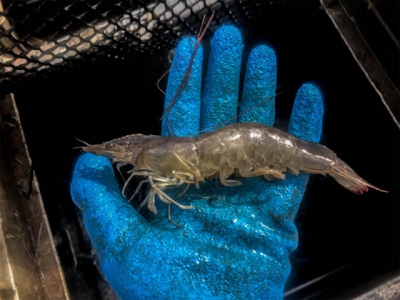Testing soy-optimized feeds and automated feeding systems in shrimp pond production Part 2

3/ Sampling and water quality
Shrimp were sampled weekly through the entire production stage using a cast net (1.52 m radius and 0.96 cm mesh) to collect approximately 60 individuals per pond. Pond sampling enabled growth assessment and inspection for general health. Ponds were monitored (DO, temperature, salinity, and pH) at least three times a day, at sunrise (5:00 to 5:30 a.m.), afternoon (2:00 to 2:30 p.m.) and sunset (7 to 8 p.m.).For maintenance of dissolved oxygen (DO) above 3 mg/L, all ponds were supplied with one 2-HP Aire-O2 (Aire-O2, Aeration Industries International, Inc., Minneapolis, MN, USA) as a main source of mechanical aeration and one Air-O-Lator (Kansas City, MO, USA) for backup and/or supplemental aeration as needed.
4/ Results
A combined summary of the past three years of research can be seen in Figs. 1 and 2. The improved growth performance from hand feeding two times per day to timer feedings is significant. By using automated feeders and increasing the feed input we were able to reduce the production cycle from 120 to 90 days. It is clear that increasing the number of feedings per day allows increases to our standard feed inputs (+30, 45 and 60 percent above SFP), which resulted in increased shrimp production.
Growth rates (grams per week) for the AQ1 system (treatment 4) were consistently the highest as it adjusted feed inputs in real time. The AQ1 treatment also had the highest yield and feed input. It is interesting to note that, although the acoustic system adjusted feed inputs based on real time inputs, there were no differences in FCR. We are conservative with our feed inputs, so even at that 160 percent level of feed inputs (SFP 60), feed was limited and the shrimp consumed all that was fed. It is likely that the shrimp also utilized natural foods present in the pond.

Fig. 1: Three-year summary of weekly average growth rate (grams/week) over the production cycle and overall food conversion ratio (FCR).

Fig. 2: Three-year summary of total feed used and final shrimp biomass.
It is important to note the soy optimized diet used in 2016 and 2018 provided similar results to the commercial shrimp diet used in 2017. Hence, the use of automatic feeders or a feeding system with acoustic feedback resulted in good growth and production. Growth was similar across all feed inputs up to about 50 days after which the lower levels of feed input limited growth.
This provides us an opportunity to use the data to develop an improved feed management strategy based on an incremental increase in inputs. Towards this goal, we will use feed inputs and growth data to back-calculate a recommended feed input for the use of automated feeding systems providing an invaluable tool for farmers using automated feeding systems.
5/ Perspectives
The results over three years of testing clearly demonstrated that increasing daily feedings through the use of automated feeding systems can significantly increase the production and value of L. vannamei produced in semi-intensive pond culture. Based on the use of automated feeding systems, we have seen large increases in shrimp growth rates and reductions in the number of days to a given size while maintaining excellent feed conversion. In general, automated feeding systems are a transformational technology which confer numerous advantages for shrimp culture. Our results confirm that a standard feeding protocol can be developed for automated feeding system that will support enhanced growth rates.
It is our opinion that simple automatic feeding systems will never match real time adjustments to feed inputs which respond to actual demand of the shrimp. Albeit implemented at a much higher cost, automated feedback systems appear to be a better management option for maximizing shrimp production in the shortest time.
It should be noted that the application of these technologies will increase feed input requiring adjustments in pond management and that personnel will need to be trained in proper maintenance of the feeding systems. It is also worth underlining that we were able to achieve more than acceptable growth performance while applying fishmeal-free soy-based diets, which are still looked with skepticism by some sub-sectors of the industry.
The combination of plant-based diets and advanced feeding technologies allow for a more efficient system which will provide a unique set of advantages if adopted by commercial producers.
References available from last author: Joao Torres Reis, Anneleen Swanepoel, M.S. Romi Novriadi, Ph.D. Melanie Rhodes, M.S and Allen Davis, Ph.D.
Related news
Tools

Phối trộn thức ăn chăn nuôi

Pha dung dịch thủy canh

Định mức cho tôm ăn

Phối trộn phân bón NPK

Xác định tỷ lệ tôm sống

Chuyển đổi đơn vị phân bón

Xác định công suất sục khí

Chuyển đổi đơn vị tôm

Tính diện tích nhà kính

Tính thể tích ao



 Breakthrough sale for shrimp sustainability initiative
Breakthrough sale for shrimp sustainability initiative  Testing soy-optimized feeds and automated feeding systems in…
Testing soy-optimized feeds and automated feeding systems in…